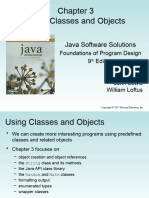0% found this document useful (0 votes)
17 views22 pagesUnit2 Java
The document discusses objects and classes in Java including what an object is, the difference between an object and a class, and how to define classes and objects in Java. It also covers constructors, strings, the Character class, and some common methods in Java.
Uploaded by
ProfessorCopyright
© © All Rights Reserved
We take content rights seriously. If you suspect this is your content, claim it here.
Available Formats
Download as PDF, TXT or read online on Scribd
0% found this document useful (0 votes)
17 views22 pagesUnit2 Java
The document discusses objects and classes in Java including what an object is, the difference between an object and a class, and how to define classes and objects in Java. It also covers constructors, strings, the Character class, and some common methods in Java.
Uploaded by
ProfessorCopyright
© © All Rights Reserved
We take content rights seriously. If you suspect this is your content, claim it here.
Available Formats
Download as PDF, TXT or read online on Scribd
/ 22





































































































